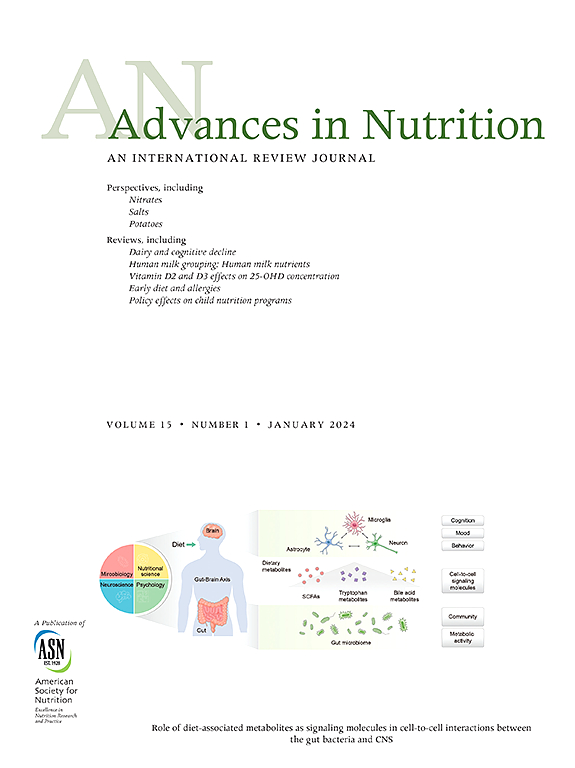Adoption or Placement in Foster Care and Catch-up in Linear Growth and Development: A Meta-Analysis of Individual Participant Data
IF 9.2
1区 医学
Q1 NUTRITION & DIETETICS
引用次数: 0
Abstract
The ability of children to recover from linear growth retardation, often referred to as catch-up growth, has intrigued researchers for many decades. Whether adoption from a low-income to a high-income setting, which provides a comprehensive improvement in the conditions that cause children to not grow well, leads to catch-up growth is unknown. We estimated the association of adoption (or placement in foster care) with catch-up in linear growth and child development before 5 y of age. We conducted a 2-stage meta-analysis using individual participant data for linear growth. We obtained study-specific and subgroup estimates and pooled the estimates using random-effects models. Sensitivity analyses were used to assess the robustness of our findings. A review of child-development outcomes was conducted. We included 485 children under 5 y of age from 9 adoption studies. At baseline, children had a mean age of 15.8 mo and a length deficit of 3.9 cm. Adoption reduced this gap by 77% or 3.0 cm (95% confidence interval [CI]: 1.9, 4.1 cm; mean age: 32.3 mo). Catch-up growth was found in both girls (3.6 cm; 95% CI: 2.9, 4.2 cm) and boys (2.5 cm; 95% CI: 1.9, 3.1 cm) and in children adopted after the age of 24 mo (2.2 cm; 95% CI: 0.6, 3.7 cm). The sensitivity analyses did not change any of the substantive findings. The magnitude of catch-up in child development (mean reduction in deficit of 46%) was smaller than that in linear growth. Catch-up in linear growth in children under 5 is biologically possible when the environment is improved profoundly and comprehensively. Partial reversal of the accumulated height deficit is more likely than recovery in developmental outcomes, which highlights the need to ensure all children grow and develop in environments that prevent deficits from occurring rather than trying to correct them.
This review was registered at PROSPERO as CRD42022298715 (https://www.crd.york.ac.uk/PROSPEROFILES/298715_PROTOCOL_20220429.pdf).
收养或安置在寄养和追赶线性成长和发展:个体参与者数据的元分析。
背景:儿童从线性生长迟缓中恢复的能力,通常被称为追赶型生长,几十年来一直引起研究人员的兴趣。从低收入环境到高收入环境的收养对导致儿童发育不良的条件提供了全面改善,但是否会导致追赶型生长尚不清楚。目的:我们估计收养(或寄养安置)与5岁前线性生长和儿童发育的追赶之间的关系。方法:我们使用个体参与者的线性增长数据进行了两阶段的荟萃分析。我们获得了研究特异性和亚组估计值,并使用随机效应模型汇总了估计值。敏感性分析用于评估我们研究结果的稳健性。对儿童发展成果进行了审查。结果:我们纳入了来自9项收养研究的485名5岁以下儿童。在基线时,儿童的平均年龄为15.8个月,长度缺陷为3.9厘米。采用将这一差距缩小了77%或3.0厘米(95% CI: 1.9-4.1厘米)(平均年龄32.3个月)。两个女孩都有追赶生长(3.6 cm;95% CI 2.9-4.2 cm)和男孩(2.5 cm;95% CI: 1.9-3.1 cm)和24个月后收养的儿童(2.2 cm, 95% CI 0.6-3.7 cm)。敏感性分析没有改变任何实质性的发现。儿童发展的追赶幅度(平均减少46%)小于线性增长。结论:当环境得到全面而深刻的改善时,五岁以下儿童的线性生长追赶在生物学上是可能的。累积的身高缺陷的部分逆转比发育结果的恢复更有可能,这突出了确保所有儿童在防止缺陷发生的环境中生长和发育的必要性,而不是试图纠正它们。注册:PROSPERO CRD42022298715;https://www.crd.york.ac.uk/PROSPEROFILES/298715_PROTOCOL_20220429.pdf意义声明:本研究首次使用个体参与者数据对收养进行荟萃分析,结果表明,收养使儿童的累计身高缺陷减少了约3厘米。线性增长的追赶比发展结果的恢复更有可能,这突出了确保儿童在防止缺陷发生而不是试图纠正缺陷的环境中生长和发展的必要性。
本文章由计算机程序翻译,如有差异,请以英文原文为准。
求助全文
约1分钟内获得全文
求助全文
来源期刊

Advances in Nutrition
医学-营养学
CiteScore
17.40
自引率
2.20%
发文量
117
审稿时长
56 days
期刊介绍:
Advances in Nutrition (AN/Adv Nutr) publishes focused reviews on pivotal findings and recent research across all domains relevant to nutritional scientists and biomedical researchers. This encompasses nutrition-related research spanning biochemical, molecular, and genetic studies using experimental animal models, domestic animals, and human subjects. The journal also emphasizes clinical nutrition, epidemiology and public health, and nutrition education. Review articles concentrate on recent progress rather than broad historical developments.
In addition to review articles, AN includes Perspectives, Letters to the Editor, and supplements. Supplement proposals require pre-approval by the editor before submission. The journal features reports and position papers from the American Society for Nutrition, summaries of major government and foundation reports, and Nutrient Information briefs providing crucial details about dietary requirements, food sources, deficiencies, and other essential nutrient information. All submissions with scientific content undergo peer review by the Editors or their designees prior to acceptance for publication.
 求助内容:
求助内容: 应助结果提醒方式:
应助结果提醒方式:


